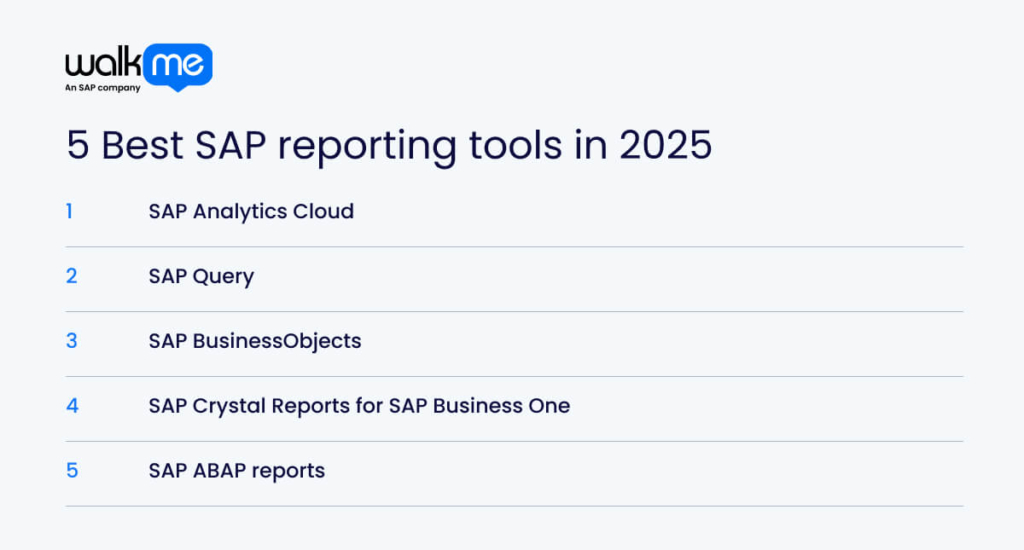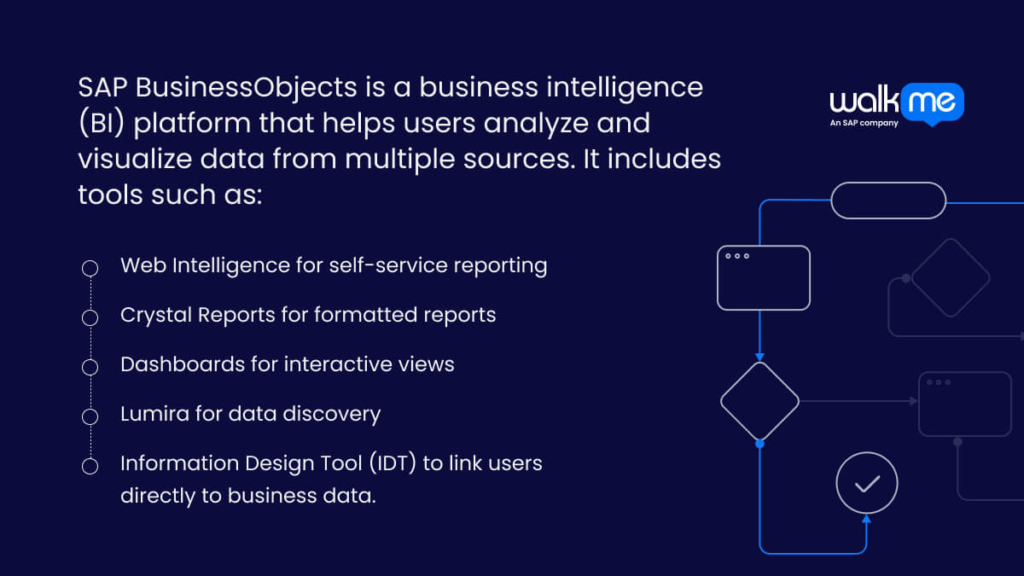Companies collect more customer journey data than before, creating both opportunity and complexity. From emails and social media to surveys, chats, and reviews, businesses gather feedback from many sources.
To make sense of this data, a cross-functional team can adopt tools like SAP reporting to analyze text and uncover trends. These tools help identify customer needs, improve decisions, and stay ahead of competitors.
With the right SAP reporting tool, organizations gain clearer insights and greater control over business performance.

In this article, we’ll explore the top five SAP reporting tools, highlight their key features, and explain how each one supports different business goals.
1. SAP Analytics Cloud
Best For: Organizations currently using the existing SAP ecosystem, as it enables seamless integration with multiple data sources.
SAP Analytics Cloud (SAC) is a cloud-native platform that combines business intelligence, planning, and predictive analytics into a single solution.
It helps teams gain real-time insights, make more informed decisions, and manage planning processes more efficiently. SAC supports users of all skill levels and connects with data from SAP, third-party apps, and spreadsheets.
Key features:
- Cloud-based: Access SAC from anywhere and reduce IT costs with a scalable solution.
- Easy for users to adopt: Easily navigate the platform, even without prior technical skills.
- Offers business Intelligence (BI) features: Build dashboards, reports, and visualizations to explore data.
- Enables financial planning in one system: Create and manage budgets, forecasts, and financial models in one place.
- Provides predictive analytics tools: Use AI to uncover trends, predict outcomes, and test scenarios.
- Improves Collaboration: Work with your team in real time and share insights quickly.
- Supports Integration: Connect data from SAP, third-party tools, and spreadsheets.
2. SAP Query
Best For: Business users who need a way to build easy and complex types of reports often using SAP data, and reduce reliance on IT.
SAP Query enables users to build custom reports from SAP data without requiring constant end-user support. It provides teams with better access to data and makes reporting tasks easier across a team.
This tool includes four main parts that work together to help employees create and manage reports:
- InfoSets: This feature enables employees to define which tables and fields users can access in their queries.
- Queries: Let users build and run reports using data from InfoSets.
- User Groups: Manage access by assigning users to specific queries and InfoSets based on their roles.
- QuickViewer: Offers a quick and easy way to create basic reports without setting up complex queries.
The two types of reports that your business can benefit from within the SAP Query tool include SAP QuickViewer and SAP Infoset Query.
Key features of SAP QuickViewer:
- Provides the ability to build basic reports without coding knowledge: Individuals with little or no ABAP knowledge can quickly build reports from single tables, joins, or InfoSets.
- Does not enable sharing: Each user creates and uses their own QuickViews feature, as the system doesn’t support easy sharing.
- Allows for the production of simple reports: Quick Viewer generates simple list reports for quick data checks. For instance, a user can quickly create a report to list all purchase orders from a single vendor.
- Offers limited features: This tool offers fewer options for formatting and calculations compared to InfoSet Query.
Key features of SAP Infoset Query:
- More powerful than QuickViewer: Users can build basic lists, statistics, and ranked reports with greater flexibility. For example, an employee can create a sales report by product category, showing totals and average prices.
- Adopts InfoSets features: Businesses can define which fields to include by setting up InfoSets.
- Supports advanced logic: Employees can add formulas, complex logic, and ABAP code.
- Works across systems: Teams can move reports to other clients or systems for broader use.
- Fits complex needs: Users rely on it for long-term, detailed, and shared reporting.
3. SAP BusinessObjects
Best For: Employees who need to analyze and visualize data from SAP and non-SAP systems, without technical knowledge.

SAP BusinessObjects is a business intelligence (BI) platform that helps users analyze and visualize data from multiple sources. It includes tools such as:
- Web Intelligence for self-service reporting
- Crystal Reports for formatted reports
- Dashboards for interactive views
- Lumira for data discovery
- Information Design Tool (IDT) to link users directly to business data.
Key features:
- Self-service BI: Business users create and explore reports without depending on IT.
- Ability to build all types of reports: You can create simple or complex reports and analyze data in-depth.
- Utilizes real-time data: Employees can connect directly to SAP HANA and Business Warehouse for live data.
- Propels data visualization: Users create charts, graphs, and maps to quickly identify trends and insights.
- Offers easy integrations with other SAP tools: Businesses connect SAP BusinessObjects with SAP tools and Microsoft Office.
- Connects to a variety of data sources: Users pull data from spreadsheets, databases, and web services.
- Enables viewing through different devices: Teams can view reports and dashboards from mobile devices at any time.
4. SAP Crystal Reports for SAP Business One
Best For: Businesses that need control over layout formatting and custom calculations for various departments.
SAP Crystal Reports for SAP Business One helps users create detailed, professional reports directly within the ERP system. While SAP BusinessObjects supports a wide range of conversational intelligence tools, Crystal Reports focuses on structured reports tailored to specific business needs, such as finance.
Businesses can benefit from key features such as:
- Custom report layouts: Full control over design to match specific business requirements and branding.
- Data source connectivity: Direct links to SAP Business One and other supported databases.
- Advanced formatting options: Tools for polished tables, charts, and visual elements.
- Export format support: Output to PDF, Excel, Word, and other common file types.
- Formula language capability: Built-in language for custom calculations and logic.
- Scheduling and delivery: Integration with Crystal Server for automated report distribution.
- SAP Business One integration: Seamless access and use within the SAP Business One environment.
5. SAP ABAP reports
Best For: Developers who adopt the ABAP language to build reports when standard tools, such as Quick Viewer or InfoSet Query, fall short.
SAP ABAP reports give businesses complete control over how they collect, process, and display data from SAP systems. These reports can handle larger data volumes and deliver custom formats that match business needs..
The types of ABAP reports on offer are:
- Classical reports: Businesses can view simple data on one screen.
- Interactive reports: This type of report enables users to click on specific details for further information.
- ALV reports: You can adopt advanced layouts with this tool.
- Report Writer or Painter reports: Organizations can utilize these types of reports to support their complex financial needs.
- Query reports: This tool enables less technical users to create reports using guided tools.
Regardless of the ABAP report you opt for, these are some of the key features you will get:
- Better data handling and processing: ABAP reports utilize Open SQL to retrieve data from SAP tables, sort it, and apply business logic across various databases.
- Different types of reports and features: Developers create classical, interactive, and ALV reports with drill-downs, sorting, and event-driven actions.
- Advanced customization abilities: Teams design custom reports, connect them to SAP modules, and apply role-based access controls.
- Enhanced performance improvements: Your business can produce reports quickly by using parallel processing, indexing, and efficient coding practices.
How to choose the right SAP reporting tool for your enterprise
Choosing the right SAP reporting tool is crucial because it enables a business to achieve its key objectives. The right tool gives clear and timely data, which helps avoid mistakes and supports data-driven decisions.
Here’s how you can opt for the right SAP reporting tool for your company:
| Type of reporting consideration | Recommended tools |
| Type of data sources | Crystal Reports works well with SAP Business One to provide targeted data retrieval. BusinessObjects or SAP Analytics Cloud offers options to combine SAP data with spreadsheets or cloud sources. |
| Employee knowledge or skills | Your employees can benefit from SAP Query or Crystal Reports if they don’t write code. Developers can adopt ABAP reports when the report needs custom logic. |
| Integrations available | Businesses can use other SAP modules when they adopt ABAP reports or SAP Query. However, if you require integrations with non-native SAP tools, consider BusinessObjects or Crystal Reports. |
| Level of analysis and detail required | If you want to create basic reports, such as sales lists, you can opt for SAP Query or Crystal Reports. For constructing advanced dashboards and planning tools, choose SAP Analytics Cloud or BusinessObjects. |
| Future reporting needs | Organizations can support long-term growth with SAP Analytics Cloud or BusinessObjects. It’s essential to note that SAP Query, also known as QuickViewer, is designed for short-term needs or small teams. |
| Licensing, implementation, and maintenance costs | SAP Query or ABAP reports help control costs since they don’t require extra licenses. SAP Analytics Cloud or BusinessObjects provides more advanced features for complex reporting needs. |
Unlocking business value with the right SAP reporting tools
SAP reporting tools help businesses turn raw data into clear, actionable insights. By choosing tools that match business processes and goals, teams can improve their access to and use of information.
Real-time, role-based reporting gives users the correct data at the right time, which speeds up decisions and increases accuracy. These tools also support better planning and performance improvement across departments.
As the SAP environment grows and changes, businesses should regularly review their reporting needs. Staying aligned with current goals and systems ensures that reporting continues to support smarter, faster decisions and drives long-term value from SAP investments.
FAQs
SAP reporting tools are a form of digital tool that can create visual reports from your company’s data. These tools include BusinessObjects (including Lumira and Web Intelligence), Crystal Reports, and built-in tools in ECC and S/4HANA. Crystal Reports creates detailed and flexible reports, while ECC and S/4HANA tools handle tasks such as financial reporting and custom data analysis.
SAP reporting tools help businesses operate more efficiently by providing access to real-time data. They enable users to spot trends, analyze information, and make informed decisions. These tools also support automation, custom reports, and teamwork, which improves productivity.
Small businesses can utilize SAP reporting tools to gain valuable insights and make informed decisions. These tools help track key metrics, simplify tasks, and use real-time data to inform actions.

